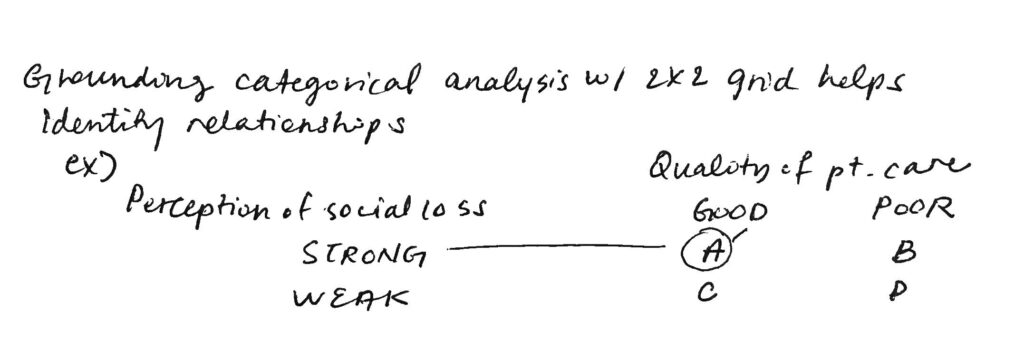
Dey, I. (2009). Grounding Categories. The SAGE Handbook of Grounded Theory, 166-190. doi:10.4135/9781848607941.n8
PART 3: Grounded Theory in Practice
By Ian Dey
June 9, 2020
This chapter is about how coding contributes to the grounding of categories. Dey does not believe in outlining how to develop grounded categories as a procedure – it must be a reflective practice (168)
- Category (according to Glaser, Strauss, 1967:36)
- “Conceptual elements of a theory”
- They first emerge from the data and are strengthened through a process of constant comparison with other instances they occur in
- Describes features of a phenomena (can perception of competence be a category?)
- Well-defined categories have attributes that define the category. In order for something to belong to a category, in must have all the attributes
- Ex. if “perception of competence” is a category, what are examples of its attributes?
- Reflection on one’s skill, desire for growth, beginning/middle of career stage?
- Categories are fuzzy, lack of clear boundaries – this is normal; categories aren’t defined with data driven rules. They’re also made “through judgement in terms of some cognitive frame of reference by which we make sense of experience” (170)
- Categorization has a cause. It explains something
- Ex. with wings a bid can fly > so it can nest in trees
- Ex. perception of competence > identifying source for knowledge
- GT theorizes a social process – am I theorizing the social process of UX designers by how they share knowledge? This is not what I imagined to be doing in my MI – but I like it.
What does it mean to ground categories?
- GT is not speculative because it comes from empirical observation
- Example of GT by Dey = “process of resisting redundancy” (for union opposition redundancies
- How would mine be framed about the way UX designers behave in sharing knowledge?
- “To discover theory, we can use a flexible, iterative, and adaptive approach to generating and utilizing data” (174) – like design thinking process
- “We tend to recognize or seek out evidence that confirms rather than refutes our expectations” (175)
- I have to also be aware when data goes against my categories and theoretical coding – be proactive about it – How?
How can categories be grounded?
- Categories have a theoretical provenance and empirical base. The theoretical provenance comes from constant comparison (176)
- Theoretical claims can be compared to well-established knowledge in the field to gain construct validity
- So, if I looked to other established sources to understand the process of self perception, would my category in perception of self competence becomes valid?
- Categories are grounded if they can explain something empirical (observed). it is not about representing. It is about explaining. Therefore categories can be used to house data that are not necessarily all identical to each other. The pattern of data within a category does not have to be consistent. Rather, the category explains what is happening in the data collected. (177)
- So, data collected in the category of perception of competence may all vary from each other? Ex. Different moments, environments, circumstance that incited self reflection?
- Social process can be conceptualized as stable / unstable, controlled / chaotic, continuous / discontinuous through GT – I wonder which UX design belongs to
- What aspect of social process of KM by UX designers am I looking for?
How categories develop
- You do not categorize first and then look for connections between categories; you connect by categorizing (178)
- Grounding categorical analysis with 2×2 grid helps identify relationships (179)

- If you only focus on A outcomes in empirical research, you miss out on deeper levels of relationships. There may be cases where people reach a social state differently than others. Ex. perception of social loss may be strong even with poor quality of patient care (179)
- Ex. UX perception of self competence may be high even without formal education
- Analysis like this builds stronger GT because you are identifying causal relationships
- When coding data, don’t treat the code as a permanent label. Coded data is categorized, and categories by nature are malleable and permeable. Be flexible towards how code can change and the meaning of the code can change. “Data is far from secure”
The storyline
- Theoretical saturation; saturation must be thought of as the density of categorization
- How can I make myself more convincing and persuasive in my narrative to prove my GT?
Reflexivity and Replication (187)
- Substantive theory can adapt to specific contexts, therefore replicable
- GT is not about repetition and replication; it’s about application and adaptation
Conclusion
What are categories? Categories are inherently theoretical, implicitly explanatory, and often metaphorical and exemplary rather than rule-bound. What does it mean to ground categories? It means generating ideas through research in ways which root categories in evidence without providing a means of independent validation of any emergent theories. How can categories be grounded? this requires keeping an open mind, rooting categories in the data being analysed, seeking the underlying logic of apparently disparate events, recognizing causal inferences at work through our categorizations, checking, revising, and amplifying techniques to evaluate evidence and explore connections between categories. Does this mean coding? There are other approaches, such as narrative analysis which, because of their interpretive grab, may play a vital role in grounding our criteria of good theorizing and not just exhausting the possibilities of refinement and elaboration. Is replication necessary? That may depend on the extent of our theoretical ambitions.
Page 188
- Narratives drive interpretation; memoing